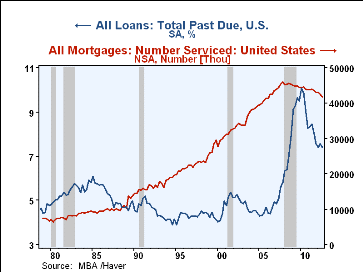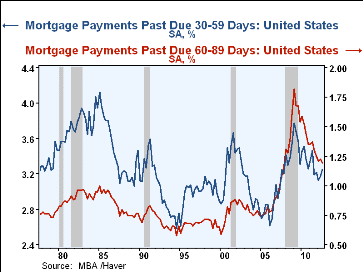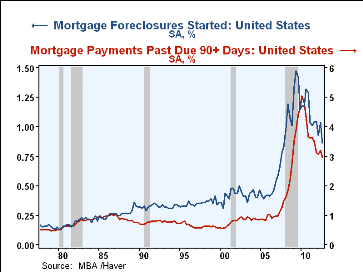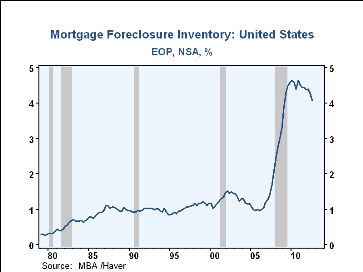 Global| Nov 16 2012
Global| Nov 16 2012U.S. Mortgage Delinquency Rates Continue Modest Improvement
Summary
The Mortgage Bankers Association reported on November 15 that delinquencies on mortgages for 1-4 family homes eased in Q3 to 7.4% of the total mortgages serviced. This ties for the lowest delinquency rate since Q3 2008, when the [...]
The Mortgage Bankers Association reported on November 15 that delinquencies on mortgages for 1-4 family homes eased in Q3 to 7.4% of the total mortgages serviced. This ties for the lowest delinquency rate since Q3 2008, when the financial market crisis was reaching its most severe. Also evident in the first graph is that the mortgage market itself is contracting, and in the latest quarter, the number of mortgages being serviced declined noticeably, indeed, by some 733,000, also the largest such move since early in the crisis period.
The delinquency rate includes all mortgages with late payments, and we see that the rate of we might call slight delinquency, 30-59 days, that is, one payment is running late, has run in a cyclical range of 2-1/2 to 3-1/2% for about the last 20 years. It was only marginally and temporarily higher than that in this cycle, peaking at 3.77% in Q1 2009. Perhaps what can be said about more recent quarters, however, is that the recovery has not brought the rate as low as it has been by this time in prior recovery-expansions.
The big difference this time is, of course, the number of loans that have run into more protracted delinquency and foreclosure. This is even readily apparent in the next period of delinquency, loans that are seeing two late payments (that is, 60-89 days). That delinquency rate had only ever reached 1.00% one time, in 1985; it has now been higher than that continually since Q2 2007, although at 1.19% in Q3 2012, it is well below its peak of 1.82% in Q1 2009.
The latter pattern of unprecedented delinquency rates is repeated in those 90 days and more and in foreclosures started during each quarter. Yes, there has been a sharp decline from peaks, but recent rates remain well above anything in historical experience. The 90-day rate was 2.96% in Q3, down noticeably from 3.19% in Q2 and a peak of 5.02% in Q1 2010, but still compares with a long-term average of about 0.77% that prevailed through the middle 2007. The foreclosure start rate eased in Q3 to 0.86% from 1.03% in Q2 and its peak of 1.47% in Q2 2009, but its long-term rate ranged from 0.23% to 0.35% from the early 1990s through 2006. Is it any wonder that mortgage lenders and mortgage analysts who try to rate and value MBS securities have been shell-shocked the last five years?
Finally, the recovery is finally resulting in some work-off of the inventory of foreclosed loans. The share of mortgages in foreclosure has been stubbornly high, but in Q3 seemed to make some downward progress; the rate fell to 4.07% from 4.27% in Q2, marking the largest single quarterly decline in the almost-34-year history of this data series. To continue the historical comparison, though, that 4.07% rate still remains almost four times as large as its 1.09% average through the middle of 2007.
The mortgage delinquency data is available in Haver's MBAMTG database. This is part of Haver's regional database offerings, with all the information available state by state as well as the national totals.
| Mortgage Delinquencies & Foreclosures(EOP, Seas. Adj.) | ||||||||
|---|---|---|---|---|---|---|---|---|
| Q3'12 | Q2'12 | 2011 | 2010 | 2009 | ||||
| All Mortgages Being Serviced (NSA, Thous.) | 41,774 | 42,507 | 42,893 | 43,660 | 44,426 | |||
| All Mortgages Past Due | 7.40% | 7.58% | 7.58% | 8.25% | 9.47% | |||
| 30-59 Days | 3.25 | 3.18 | 3.22 | 3.26 | 3.31 | |||
| 60-89 Days | 1.19 | 1.22 | 1.25 | 1.35 | 1.54 | |||
| 90 Days and Over | 2.96 | 3.19 | 3.11 | 3.65 | 4.62 | |||
| Foreclosures Started during Qtr | 0.86 | 1.03 | 4.12 | 4.95 | 5.37 | |||
| Foreclosure Inventory (End of Qtr) | 4.07 | 4.27 | 4.38 | 4.64 | 4.58 | |||
Carol Stone, CBE
AuthorMore in Author Profile »Carol Stone, CBE came to Haver Analytics in 2003 following more than 35 years as a financial market economist at major Wall Street financial institutions, most especially Merrill Lynch and Nomura Securities. She has broad experience in analysis and forecasting of flow-of-funds accounts, the federal budget and Federal Reserve operations. At Nomura Securites, among other duties, she developed various indicator forecasting tools and edited a daily global publication produced in London and New York for readers in Tokyo. At Haver Analytics, Carol is a member of the Research Department, aiding database managers with research and documentation efforts, as well as posting commentary on select economic reports. In addition, she conducts Ways-of-the-World, a blog on economic issues for an Episcopal-Church-affiliated website, The Geranium Farm. During her career, Carol served as an officer of the Money Marketeers and the Downtown Economists Club. She has a PhD from NYU's Stern School of Business. She lives in Brooklyn, New York, and has a weekend home on Long Island.









